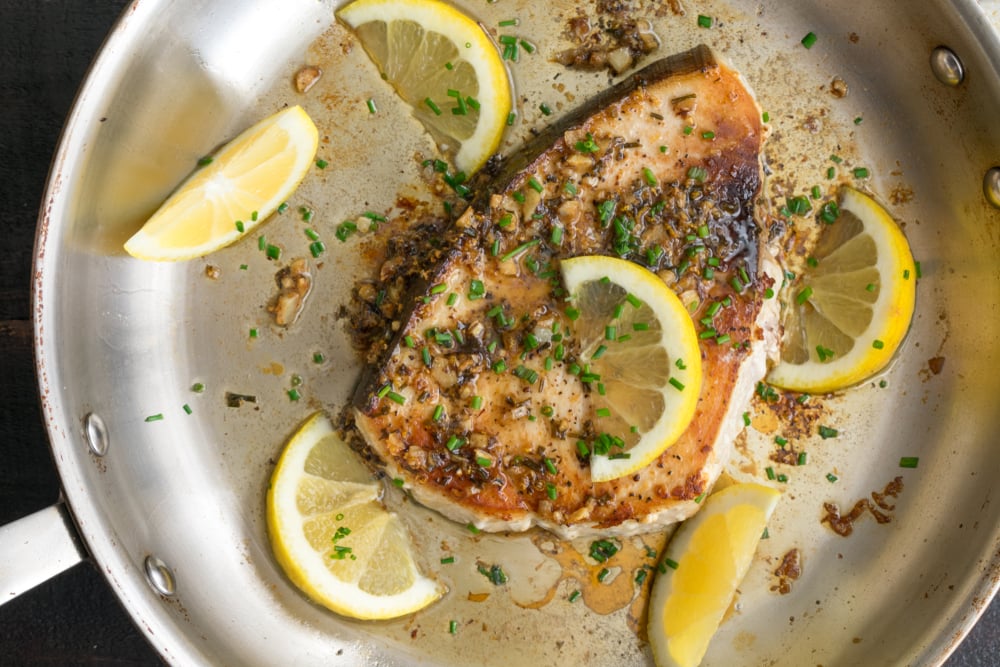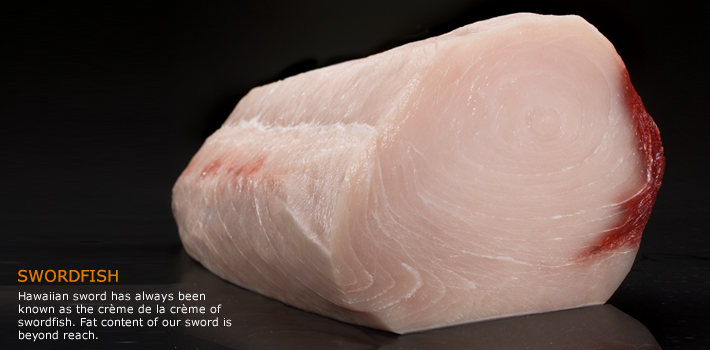Introduction

Swordfish, a beloved seafood delicacy, is celebrated for its unique flavor and versatility in culinary dishes. With a mild yet distinctive taste, swordfish offers a delightful combination of savory and slightly sweet flavors. Its firm and meaty texture adds to its appeal, making it a popular choice among seafood enthusiasts. In this article, we will explore the flavor profile of swordfish, comparing it to other seafood options, and delve into the various cooking methods and seasonings that enhance its taste. Additionally, we will also highlight the health benefits and offer delicious recipe ideas to inspire your culinary adventures.
What Is Swordfish?
Swordfish is a type of large predatory fish that is found in both temperate and tropical waters. It belongs to the billfish family and is known for its distinctive long bill, resembling a sword, from which it gets its name. Swordfish are highly prized for their meat, which is firm and flavorful. They are known for their impressive size, with adults reaching lengths of up to 14 feet and weighing over 1,000 pounds. Swordfish are commonly caught through commercial and recreational fishing and are a popular choice in culinary dishes worldwide.
Why Is Swordfish Popular In Culinary Dishes?
Swordfish is popular in culinary dishes for several reasons. Firstly, its firm texture and meaty consistency make it a versatile ingredient that can be cooked in various ways, such as grilling, baking, or pan-searing. Its mild and sweet flavor profile appeals to a wide range of palates, making it a favorite choice for seafood lovers. Additionally, swordfish has a high protein content and is low in fat, making it a healthy option for those looking to maintain a balanced diet. Its large size also makes it suitable for feeding a crowd, making it a popular choice in restaurants and for special occasions.
Texture And Appearance

Swordfish is known for its distinctive texture and appearance. With a firm and meaty texture, it offers a satisfying bite that holds up well to different cooking methods. Whether it is grilled, baked, or pan-seared, swordfish retains its texture, making it a versatile ingredient in various culinary dishes. In terms of appearance, swordfish has a white to pinkish color, depending on the cut and freshness. Its large size and streamlined body shape give it a visually striking presence, making it an attractive choice for presentation on the plate.
Swordfish Texture: Firm And Meaty
Swordfish is renowned for its firm and meaty texture, offering a satisfying bite that holds up well to various cooking methods. Whether grilled, baked, or pan-seared, this fish retains its texture, making it a versatile ingredient in culinary dishes. Its dense and substantial texture is akin to that of a cooked steak, providing a satisfying and substantial eating experience. This firmness allows swordfish to withstand high heat and maintain its integrity, making it an excellent choice for grilling aficionados. Its substantial texture complements the mild and sweet flavor, creating a harmonious balance in every bite.
Swordfish Appearance: White To Pinkish Color
Swordfish is known for its distinct appearance, which ranges from white to a slightly pinkish color. The flesh of swordfish is typically white, but it can have a slightly pink hue due to the presence of myoglobin, a protein found in muscle tissue. The color of swordfish fillets can vary depending on factors such as the fish’s diet, age, and location. When choosing swordfish at the grocery store or fish market, look for firm, smooth, and moist fillets with a vibrant color. Fresh swordfish should have a clean and mild aroma.
Flavor Profile

Swordfish has a mild and sweet flavor that is often described as meaty and rich. It has a clean taste with a hint of sweetness, making it appealing to a wide range of palates. The flavor of swordfish is often compared to that of a cross between tuna and halibut. It pairs well with various seasonings and marinades, allowing for versatility in cooking. Whether grilled, broiled, or pan-seared, swordfish maintains its distinct flavor profile and remains tender and moist. Its versatility in taste makes swordfish a popular choice for many culinary uses.
Swordfish Flavor: Mild And Sweet
Swordfish has a mild and sweet flavor that is often described as meaty and rich. It has a clean taste with a hint of sweetness, making it appealing to a wide range of palates. The flavor of swordfish is often compared to that of a cross between tuna and halibut. It pairs well with various seasonings and marinades, allowing for versatility in cooking. Whether grilled, broiled, or pan-seared, swordfish maintains its distinct flavor profile and remains tender and moist. Its versatility in taste makes swordfish a popular choice for many culinary uses.
Swordfish Taste: Comparisons To Other Seafood
When it comes to comparing the taste of swordfish to other seafood, it is often likened to a cross between tuna and steak. While swordfish shares the mildness and subtle sweetness of tuna, it also possesses a richness and meaty flavor similar to steak. Unlike flaky fish, the texture of swordfish is firm and substantial, making it a popular choice for those who prefer a heartier seafood option. Whether you enjoy the delicate flavor of tuna or the robustness of steak, swordfish offers a unique combination that is sure to please seafood enthusiasts.
Cooking Swordfish

When it comes to cooking swordfish, there are several popular methods that bring out its delicious flavor and ensure a perfect texture. Grilling is a common choice as it helps to enhance the meaty taste of the fish while adding a beautiful smoky char. Swordfish can also be baked, sautéed, or even broiled to create a mouthwatering dish. It is important to cook swordfish to an internal temperature of 145°F (63°C) to ensure it is cooked through but still juicy. Pairing swordfish with citrus or herb marinades adds a delightful burst of flavor to this versatile seafood option. Overall, cooking swordfish is a breeze and offers endless possibilities for creating delectable meals.
Popular Swordfish Cooking Methods
Popular Swordfish Cooking Methods include grilling, baking, sautéing, and broiling. Grilling is a popular choice as it enhances the meaty flavor and adds a smoky char to the fish. Baking is another option that cooks the swordfish evenly and helps to retain its moisture. Sautéing the swordfish in a pan with some olive oil creates a delicious crispy exterior. Broiling is a quick and convenient method that gives the fish a nice char on the surface. These methods offer a range of flavors and textures that suit different preferences and cuisines.
Recommended Seasonings And Marinades
When it comes to seasoning and enhancing the flavor of swordfish, there are several options to choose from. Some popular seasonings include garlic, lemon zest, black pepper, and fresh herbs like rosemary and thyme. These ingredients add a burst of freshness and complement the mildness of the swordfish. For a tangy and citrusy flavor, marinades with lemon juice or lime juice are commonly used. Additionally, a combination of olive oil, soy sauce, and garlic can create a savory and umami-rich marinade. Experimenting with different seasonings and marinades allows you to customize the taste of your swordfish to suit your palate.
Health Benefits

Swordfish offers a variety of health benefits. It is rich in selenium, a powerful antioxidant that helps protect cells from damage and supports a healthy immune system. Additionally, swordfish is a good source of niacin, which aids in digestion and maintains the health of the nervous system. The fish also contains omega-3 fatty acids, which are known for their heart-health benefits. Incorporating swordfish into your diet can contribute to overall well-being and provide essential nutrients. It is important to note that individuals should consume swordfish in moderation due to its mercury content.
Swordfish Nutrition Facts
Swordfish is not only delicious but also packed with essential nutrients. A 3-ounce serving of cooked swordfish contains approximately 146 calories, 20 grams of protein, and 6 grams of fat. It is also a good source of selenium, a powerful antioxidant that supports a healthy immune system. Additionally, swordfish provides niacin, a B vitamin that aids in digestion and maintains nervous system health. Furthermore, swordfish is rich in omega-3 fatty acids, known for their heart-health benefits. However, it’s important to consume swordfish in moderation due to its mercury content.
Omega-3 Fatty Acids And Other Nutrients
Swordfish is not only delicious but also packed with essential nutrients. A 3-ounce serving of cooked swordfish contains approximately 146 calories, 20 grams of protein, and 6 grams of fat. It is also a good source of selenium, a powerful antioxidant that supports a healthy immune system. Additionally, swordfish provides niacin, a B vitamin that aids in digestion and maintains nervous system health. Furthermore, swordfish is rich in omega-3 fatty acids, known for their heart-health benefits. However, it’s important to consume swordfish in moderation due to its mercury content.
Conclusion

In conclusion, swordfish is a highly versatile fish with a mild and sweet flavor profile. Its firm and meaty texture makes it perfect for grilling, broiling, or pan-searing. Swordfish pairs well with a variety of seasonings and marinades, allowing for endless culinary creations. Additionally, it is packed with essential nutrients such as protein, omega-3 fatty acids, and selenium. However, due to its mercury content, it is important to consume swordfish in moderation. Overall, swordfish offers a delicious and nutritious seafood option for those looking to explore new flavors in their culinary adventures.
Summing Up Swordfish Flavor And Versatility
Summing up, swordfish is a highly versatile fish with a mild and sweet flavor profile. Its firm and meaty texture makes it perfect for grilling, broiling, or pan-searing. Swordfish pairs well with a variety of seasonings and marinades, allowing for endless culinary creations. Additionally, it is packed with essential nutrients such as protein, omega-3 fatty acids, and selenium. However, due to its mercury content, it is important to consume swordfish in moderation. Overall, swordfish offers a delicious and nutritious seafood option for those looking to explore new flavors in their culinary adventures.
Delicious Swordfish Recipe Ideas
Looking for delicious ways to enjoy swordfish? Here are some recipe ideas that will surely tantalize your taste buds.
- Grilled Swordfish with Lemon Butter: Marinate swordfish steaks in a mixture of lemon juice, garlic, and herbs, then grill them to perfection. Finish with a drizzle of lemon butter sauce for a burst of tangy flavor.
- Swordfish Tacos: Season swordfish with a mix of spices like cumin, paprika, and chili powder, then grill or pan-fry them until cooked through. Serve in warm tortillas with fresh salsa, avocado, and a squeeze of lime.
- Swordfish Skewers: Cut swordfish into chunks and thread them onto skewers along with bell peppers, onions, and cherry tomatoes. Grill until the fish is cooked and serve with a flavorful dipping sauce.
- Swordfish Piccata: Lightly bread swordfish fillets and pan-fry them until crispy. Top with a tangy sauce made with lemon, capers, and white wine for a classic Italian-inspired dish.
These recipe ideas showcase the versatility of swordfish and will allow you to explore different flavors and cooking techniques. Enjoy the rich and succulent taste of swordfish in these delectable dishes.
FAQ: What Does Swordfish Taste Like?
Q: What is swordfish?
A: Swordfish is a large predatory fish found in both temperate and tropical waters around the world. It is highly valued as a food fish for its firm texture and mild flavor.
Q: How would you describe the taste of swordfish?
A: Swordfish has a distinct flavor that is often described as meaty, rich, and slightly sweet. Its taste is often compared to that of tuna, though swordfish tends to be milder and less oily.
Q: Is swordfish a delicate or robust-flavored fish?
A: Swordfish falls on the milder side of the seafood flavor spectrum, making it an excellent choice for those who prefer fish with a less pronounced taste. However, it still offers enough flavor to be enjoyable for seafood enthusiasts.
Q: Does swordfish taste fishy?
A: Unlike some other types of fish, swordfish is generally not very fishy in taste. It has a clean and almost neutral flavor profile, which makes it a great option for those who are not fond of strong fishy flavors.
Q: What is the texture of swordfish like?
A: Swordfish has a firm and steak-like texture. Its meaty consistency, often likened to chicken or steak, holds up well when cooked, making it a versatile choice for grilling, baking, or pan-searing.
Q: How does swordfish hold up to different cooking methods?
A: Swordfish is a versatile fish that can be prepared using various cooking methods. Its firm texture makes it perfect for grilling or broiling, as it can withstand high heat without falling apart. It can also be baked, pan-seared, or even used in hearty fish stews.
Q: What are some popular ways to prepare swordfish?
A: Swordfish can be enjoyed in a variety of delicious dishes. Some popular preparations include grilling swordfish steaks and serving them with a flavorful marinade or sauce, pan-searing swordfish with a squeeze of lemon or a herb-infused butter, or even incorporating diced swordfish into fish tacos or kebabs.
Q: Can you provide some tips for cooking swordfish?
A: Absolutely! When cooking swordfish, it is important not to overcook it, as it can become dry and lose its tenderness. Aim for a medium to medium-rare doneness to fully appreciate its natural flavors. Additionally, swordfish pairs well with citrus, herbs, and bold flavors such as ginger or soy sauce, so don’t be afraid to get creative with your seasonings and marinades.
Q: Are there any health considerations when consuming swordfish?
A: Swordfish is a good source of lean protein and essential nutrients such as omega-3 fatty acids, vitamin D, and vitamin B12. However, due to its position in the marine food chain, swordfish may accumulate mercury, so it should be consumed in moderation, especially for pregnant women or young children.
In conclusion, swordfish offers a mild, meaty flavor with a firm texture that can be enjoyed in various ways. Whether grilled, baked, or pan-seared, it is a versatile fish that pairs well with a wide range of flavors. Remember to cook it to a medium to medium-rare doneness and be mindful of mercury levels when consuming swordfish.

From At-Home Dinner Parties to Family Reunions to Office Parties, we can cater your next Event!